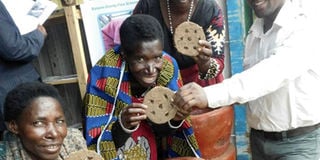Residents embrace energy saving stoves to save forests

Impact. Kisoro residents and BMCT monitoring and evaluation officer Phares Kakuru display the energy saving stoves. PHOTO BY ROBERT MUHEREZA
What you need to know:
- Clay is prepared, sorted and kept for about two weeks in cold conditions.
- Dry grass is and mixed with the sorted clay to avoid cracks.
- Then the mixture is molded into desired shapes of the stoves using hands.
- The molded shapes are dried in the sun. Then they are ready for use.
Residents living around Bwindi and Mgahinga national parks in Kisoro and Rubanda districts have embraced the use of energy saving stoves in a bid to minimise the cutting down of trees for firewood and charcoal in the conservation areas.
The stoves, which use less firewood and charcoal, also emit less smoke, which has adverse health effects.
The initiative to train the residents about using energy saving stoves is being undertaken by the Bwindi Mgahinga Conservation Trust (BMCT), a non-governmental organisation. About 245 residents have so far benefitted.
The BMCT officer in-charge of monitoring and evaluation, Mr Phares Kakuru, says their intervention was prompted by a survey which showed that the scarcity of wood fuel was pushing residents to destroy the forests in the two national parks, destroying habitats for wild animals, especially mountain gorillas.
“The energy saving stoves are made using dry grass and clay or bricks, sand and saw dust. They are made in different sizes depending on the size of the household saucepans. An analysis was made concerning the importance of energy saving stoves over the traditional three cooking stones, and it was found out that they use less firewood, improve kitchen hygiene and they save time,” says Mr Kakuru.
The community development officer for Nyarusiza Sub-county in Kisoro District, Ms Annette Tumwebaze, says BMCT’s initiative is conserving the environment.
“These stoves reduce accidental burns among children, especially those at the crawling stage, because they are stable on the ground and a bit raised. They also use less fire wood, hence reducing deforestation and smoke emitted into the atmosphere that depletes the ozone layer,” says Mr Tumwebaze.
BMCT officials say the three-stone traditional stoves consume 28 pieces of firewood to prepare a meal for six people compared to the energy saving stoves, which use only four pieces.



